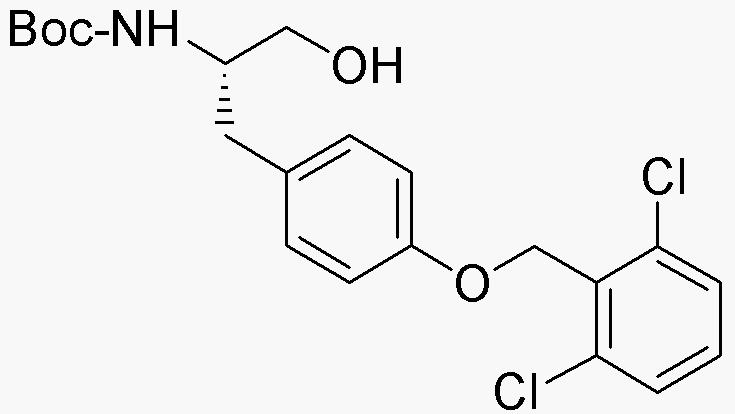Boc-O-2,6-dichlorobenzyl-L-tyrosinol is widely utilized in research focused on:
- Pharmaceutical Development: This compound serves as a key intermediate in synthesizing various pharmaceuticals, particularly those targeting neurological disorders, enhancing drug efficacy and specificity.
- Biochemical Research: It is used in studies investigating enzyme interactions and protein functions, aiding researchers in understanding complex biological processes.
- Organic Synthesis: The compound is valuable in organic chemistry for creating diverse chemical structures, allowing chemists to explore new compounds with potential therapeutic applications.
- Material Science: Its unique properties make it suitable for developing advanced materials, such as coatings or polymers, that require specific chemical resistance or stability.
- Analytical Chemistry: This chemical is utilized in various analytical techniques, helping in the detection and quantification of other substances, which is crucial for quality control in manufacturing.
General Information
Properties
Safety and Regulations
Applications
Boc-O-2,6-dichlorobenzyl-L-tyrosinol is widely utilized in research focused on:
- Pharmaceutical Development: This compound serves as a key intermediate in synthesizing various pharmaceuticals, particularly those targeting neurological disorders, enhancing drug efficacy and specificity.
- Biochemical Research: It is used in studies investigating enzyme interactions and protein functions, aiding researchers in understanding complex biological processes.
- Organic Synthesis: The compound is valuable in organic chemistry for creating diverse chemical structures, allowing chemists to explore new compounds with potential therapeutic applications.
- Material Science: Its unique properties make it suitable for developing advanced materials, such as coatings or polymers, that require specific chemical resistance or stability.
- Analytical Chemistry: This chemical is utilized in various analytical techniques, helping in the detection and quantification of other substances, which is crucial for quality control in manufacturing.
Documents
Safety Data Sheets (SDS)
The SDS provides comprehensive safety information on handling, storage, and disposal of the product.
Product Specification (PS)
The PS provides a comprehensive breakdown of the product’s properties, including chemical composition, physical state, purity, and storage requirements. It also details acceptable quality ranges and the product's intended applications.
Certificates of Analysis (COA)
Search for Certificates of Analysis (COA) by entering the products Lot Number. Lot and Batch Numbers can be found on a product’s label following the words ‘Lot’ or ‘Batch’.
Numéro de catalogue
Numéro de lot/série
Certificates Of Origin (COO)
This COO confirms the country where the product was manufactured, and also details the materials and components used in it and whether it is derived from natural, synthetic, or other specific sources. This certificate may be required for customs, trade, and regulatory compliance.
Numéro de catalogue
Numéro de lot/série
Safety Data Sheets (SDS)
The SDS provides comprehensive safety information on handling, storage, and disposal of the product.
DownloadProduct Specification (PS)
The PS provides a comprehensive breakdown of the product’s properties, including chemical composition, physical state, purity, and storage requirements. It also details acceptable quality ranges and the product's intended applications.
DownloadCertificates of Analysis (COA)
Search for Certificates of Analysis (COA) by entering the products Lot Number. Lot and Batch Numbers can be found on a product’s label following the words ‘Lot’ or ‘Batch’.
Numéro de catalogue
Numéro de lot/série
Certificates Of Origin (COO)
This COO confirms the country where the product was manufactured, and also details the materials and components used in it and whether it is derived from natural, synthetic, or other specific sources. This certificate may be required for customs, trade, and regulatory compliance.


